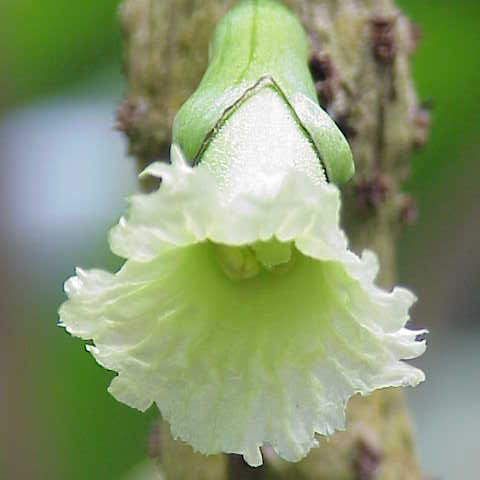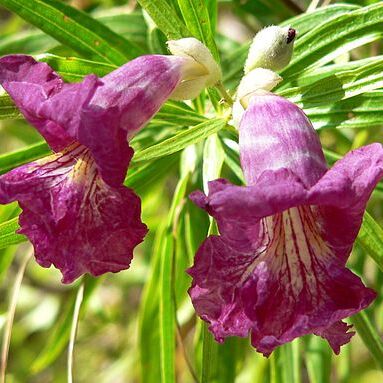Trees, shrubs, or vines, climbers rarely herbs. Leaves opposite, alternate, or whorled, simple or pinnately compound, rarely palmately compound, without stipules, climbers usually with tendrils modified sometimes into hooks or suckers. Inflorescences cymose, paniculate, or racemose, terminal or axillary, rarely flowers borne on old stems; bracts and bractlets present, sometimes deciduous. Flowers bisexual, zygomorphic, usually large. Calyx campanulate or tubular, truncate, 2-5-dentate, or glandular subulate-dentate. Corolla campanulate or funnelform, usually bilabiate; lobes 5, imbricate or valvate. Fertile stamens 4 (didynamous) and staminode 1, or 2 and staminodes 3, rarely all 5 stamens fertile. Disc fleshy. Ovary superior, 2-locular, rarely 1-or 4-locular; placentation axile or parietal; ovules numerous. Style filiform; stigma 2-lobed. Capsule dehiscing loculicidally or septicidally, rarely fruit fleshy and indehiscent. Seeds numerous, usually winged or with tufts of hairs at both ends; endosperm absent.
Stamens epipetalous, usually 4, didynamous with l posticous staminode, not so often 5 equal stamens, very rarely 2 (not in Flora Zambesiaca area) adnate to the corolla tube, included or exserted; filaments slender, often dilated at the base; anthers 2-thecous, rarely l-thecous (not in Flora Zambesiaca area), usually widely divergent or divaricate, dehiscing longitudinally
Ovary superior, syncarpus 2-carpellary, typically bilocular with axile placentation or unilocular and with parietal placencation (Kigelia); ovules numerous in each locule, anatropous; style 1, terminal with bilamellate stigma
Leaves usually opposite, rarely verticillate or alternate, imparipinnate or bipinnate (not in Flora Zambesiaca area), 1-jugate or simple, sometimes the terminal leaflet replaced by a tendril (not in Flora Zambesiaca area)
Leaves opposite, rarely alternate, mostly compound, digitate or pinnate, sometimes the terminal leaflet tendril-like (but not in the native genera of W.Africa); stipules absent, pseudostipules present in some genera
Seeds numerous, compressed and winged in the species with capsular fruits, wingless seeds in the species with fleshy fruits, without endosperm; embryo usually flat; cotyledons flattened, rarely folded, foliaceous
Anthers connivent in pairs or rarely free, 2-celled, opening lengthwise; staminode representing the fifth stamen often short, sometimes absent, often 3 present when only two stamens
Corolla gamopetalous bilabiate or not, with a conspicuous campanulate, infundibuliform or tubular tube and 5-lobed, limb usually imbricate in aestivation
Flowers zygomorphic, usually showy and in several-flowered terminal or axillary panicles or racemes, sometimes reduced to a fascicle or solitary flower
Fruit usually capsular, dehiscing by 2 loculicidal or septicidal valves, perpendicular or parallel to the septum, or fleshy and indehiscent (Kigelia)
Stipules absent, rarely with pseudostipules (external scales of axillary shoots) well developed, sometimes foliacepus
Trees and shrubs, sometimes straggling (sometimes climbers, very rarely herbaceous), mostly unarmed, not lactiferous
Calyx gamosepalous of various shapes, usually 5-dentate or-lobed or almost truncate or spathaceously split
Ovary superior, 2-celled with 2 placentas in each cell or 1-celled with parietal bifid placentas
Corolla with 5 imbricate lobes sometimes forming 2 lips, the upper of 2, the lower of 3 lobes
Calyx campanulate, closed or open in bud, truncate or 5-toothed, sometimes spathaceous
Disk hypogynous, nectariferous, annual or tubular, sometimes absent
Stamens alternate with the corolla-lobes, only 4 or 2 perfect
Flowers often showy, hermaphrodite, more or less zygomorphic
Seeds often winged, without endosperm; embryo straight
Trees or shrubs, sometimes scandent, very rarely herbs
Style terminal, 2-lipped; ovules numerous
Fruit capsular or fleshy and indehiscent
Disk usually present


